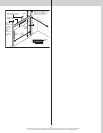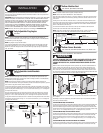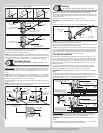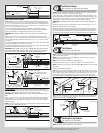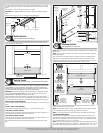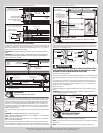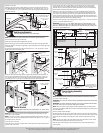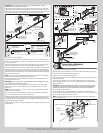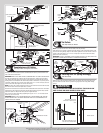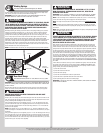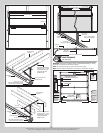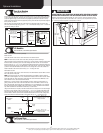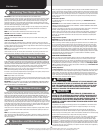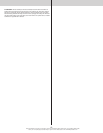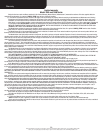
Please Do Not Return This Product To The Store. Contact your local Wayne-Dalton dealer. To find your local Wayne-Dalton dealer,
refer to your local yellow pages business listings or go to the Find a Dealer section online at www.Wayne-Dalton.com
Center
bearing
Coupler
assembly
Center bearing bracket(s)
Torsion
keyed
shaft
Center bearing inside
torsion spring
Torsion
spring
Typical center bracket
assembly
Stationary spring cone
(2) 3/8”-16 x 1-1/2”
Hex head bolts
(2) 3/8”-16 Nuts
Torsion
spring
Torsion
spring
Torsion
keyed
shaft
Coupler
halves
Center bearing brackets
Torsion
keyed
shaft
Coupler
assembly
(3) 3/8” - 16
nylon hex lock
nuts
(3) 3/8” - 16 x 1-3/4”
hex head screws
Set screws
Lock nuts
Counterbalance Lift Cables
Tools: Step Ladder, Locking Pliers, 3/8” Wrench
20
Starting on the left hand side, thread the counterbalance lift cable up and around the front
side of the left hand cable drum.
IMPORTANT: VERIFY THAT THERE ARE NO COUNTERBALANCE LIFT CABLE OBSTRUCTIONS.
Hook the counterbalance lift cable into the left hand cable drum. Starting on the left hand
side, slide the left hand cable drum onto the torsion shaft and up against the left hand end
bearing bracket. Counterbalance lift cable should provide a minimum of 1/2 pre-wrap on the
cable drum. Tighten the (2) set screws in the cable drum to 14-15 ft. lbs. of torque (once set
screws contact the shaft, tighten set screws one full turn).
NOTE: For doors with a torsion keyed shaft, insert (1) key shaft into the slot of both the cable
drum and the slot in the torsion keyed shaft, as shown.
Rotate the left hand drum and torsion shaft until counterbalance lift cable is taut. Now attach
locking pliers to the torsion shaft and brace locking pliers against the jamb to keep counter-
balance lift cable taut. Repeat the same process for right hand side.
Now, secure the coupler assembly by tightening the (3) 3/8”-16 x 1-3/4” hex head screws
and the (3) 3/8”-16 hex nuts.
IMPORTANT: INSPECT EACH COUNTERBALANCE LIFT CABLES MAKING SURE THEY ARE
SEATED PROPERLY ONTO THE CABLE DRUMS AND THAT BOTH COUNTERBALANCE LIFT
CABLES HAVE EQUAL TENSION.
Jamb
Locking
pliers
Torsion
shaft
Left hand
end bearing
bracket
Counterbalance lift cable
Counterbalance lift
cable installed
Cable drum
set screws
Left hand
cable
drum
Torsion
keyed
shaft
Coupler
halves
Center bearing brackets
Torsion
keyed
shaft
Coupler
assembly
(3) 3/8” - 16
nylon hex lock
nuts
(3) 3/8” - 16 x 1-3/4”
hex head screws
Set screws
Lock nuts
Left hand end
bearing bracket
Torsion
keyed
shaft
Torsion spring
Key
Left hand
cable drum
Set Collars
Tools: Step Ladder, 3/8” Wrench
21
NOTE: If your door did not come with set collars, then skip this step.
Slide each of the set collars up against the inside surface of the end bearing brackets, with
the set screw facing directly away from the header. Tighten the set screw in each of the set
collars to the torsion shaft to 14-15 ft. lbs. of torque (once set screw contacts the shaft,
tighten set screw one full turn).
IMPORTANT: PRIOR TO TIGHTENING THE SET SCREWS IN THE SET COLLARS, AVOID PLAC-
ING THE SET SCREWS IN THE KEYWAYS OF TORSION KEYED SHAFT(S).
Set
collar
End bearing
bracket
Torsion
keyed shaft
End
bearing
bracket
Set
collar
Set
screw
Counterbalance
lift cable
Right
hand
cable
drum
Securing Door For Spring Winding(s)
Tools: Vice Clamps
22
With the door in the fully closed position, place vice clamps onto both vertical tracks just
above the third track roller. This is to prevent the garage door from rising while winding
springs.
WARNING WARNING
FAILURE TO PLACE VICE CLAMPS ONTO VERTICAL TRACK CAN ALLOW
DOOR TO RAISE AND CAUSE SEVERE OR FATAL INJURY.
Vice clamps above third
track roller on both sides of
door
Bottom section
Vice clamps attached to inner
and outer rail of vertical track
14



